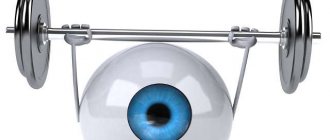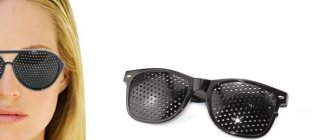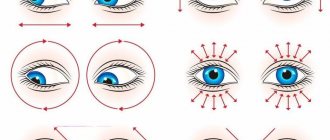Currently, vision problems have acquired unprecedented proportions. The issue of visual impairment is increasingly affecting children and adolescents; more and more people are turning to doctors with myopia. The most popular method of vision correction remains spectacle correction due to its accessibility and safety. We will tell you how to wear glasses correctly for myopia in this article.
Causes of myopia
Myopia or, more simply, myopia can occur at any age. It can be either a congenital or acquired disease. There are also often cases of a combination of myopia and astigmatism.
Myopia (myopia)
This pathology occurs as a result of dysfunction of the muscle tissue of the eye, which leads to the inability of the lens to adapt to the external environment. The normal functioning of the eyeball is characterized by focusing sunlight strictly on the retina due to changes in the thickness of the lens. With myopia, a picture located at a distance does not reach the bottom of the eye, and its focus is directly on the surface of the eyes. In this case, the image seems to be blurred.
A person with myopia has difficulty seeing distant objects
Problems with visual acuity cause a lot of inconvenience to a person. A good vision of the world around us is necessary for everyone, not only in work, but also in everyday life. What to do if a person is faced with such a vision pathology?
Note! The main means of correcting myopia are glasses with special lenses that seem to remove defects in the eye structure. But this is only a measure to correct the result of the disease; glasses cannot cure the very cause of myopia. Optical vision correction serves only as a tool for improving vision, but not as a cure for the disease.
Degrees of myopia
Correcting myopia with glasses
During the correction of visual anomalies with glasses, the user's visual acuity stabilizes. Thanks to this, rapid eye fatigue, dizziness and headaches that could previously bother the patient disappear.
In addition, properly selected glasses reduce the risk of possible complications. The most common of them include amblyopia, strabismus, dystrophic changes in the fundus, pathology of the optic nerve and retinal detachment.
The optical market offers a wide variety of types of glasses for myopia correction. Photochromic, sun-protection, and computer-based ones are also recommended. The first two models not only provide a person with good vision, but also protect the visual organs from exposure to sunlight and ultraviolet radiation. The peculiarity of computer glasses is that the surface of their lenses is coated with a special coating that prevents rapid eye fatigue - a filter for the blue-violet spectrum that the monitor emits. There are also multifocal lenses equipped with several optical zones for near and distance vision. They eliminate the need for the user to use multiple pairs of glasses.
Causes of myopia
Among the causes of myopia are the following:
- hereditary factor;
- change in the length of the ocular axis;
- poor adaptation of the eyes to the external environment;
- intense work of the eye muscles at close range for a long time;
- geographical and natural factors.
Myopia can be either a congenital or acquired disease.
Types of corrective therapy for myopia
There are several ways to correct vision in the treatment of myopia.
- Optics, that is, glasses.
- Contact lenses.
- Laser correction methods.
Myopia treatment
Glasses in the fight against myopia
Myopia is a common problem associated with dysfunction of the visual system. According to statistics, a good half of humanity suffers from this disease. The most affordable way to eliminate the problem is to use glasses with specially selected lenses. These lenses are integrated into the frame shell in such a way that they create a diffuse effect due to the concave shape of the glass. Their action is based on the refraction of light rays so that the focus of the image being viewed is precisely on the retina of the eyeball. Thanks to this, a person sees much better.
Glasses for myopia
How to choose glasses? The answer to this question lies in the knowledge of imaging in myopathy. Namely: the picture is focused not on the retina, but under it . To move the focus to the retina, you must use concave lenses, which are indicated by a minus symbol. As a result, correction agents have a minus sign.
Computer glasses for myopia
Computer glasses are prescribed to prevent the progression of disorders. They help prevent eye strain when working in front of a monitor for a long time, and glasses with a special coating also protect against radiation. An interference filter absorbs light in the violet-blue spectrum, but allows enough sunlight to pass through.
Computer glasses can have refractive power and can be used to correct myopia. In this case, the lenses should be two diopters weaker than the lenses for permanent correction. The optical characteristics of such glasses help reduce eye strain when working with modern gadgets.
Vision correction: lenses or glasses?
Treatment with contact lenses
Note! To understand what is better to use to correct myopia - glasses or contact lenses, you need to know that the selection of vision correction means is purely individual. This means that glasses may be more suitable for one patient and contact lenses for another. It all depends on the degree of myopia.
In cases where myopia is weak, no more than one diopter, it would be advisable to wear glasses. For such patients there is no need for constant use of optics; glasses can be used as needed. For example, when you need to look at a picture in the distance, you can use special models of glasses, and the rest of the time you can take them off as unnecessary.
Some people prefer glasses, others prefer contact lenses.
However, if there is a high degree of myopia and a person sees poorly without vision-correcting optics, then it makes sense to use contact lenses. Firstly, they do not need to be constantly taken off and put on. Secondly, the lenses provide 100% visibility, unlike glasses, which, in case of poor vision, do not provide full visibility of the image. In addition, lenses have an undeniable advantage in the form of an aesthetically attractive appearance for a person. Unlike glasses, they do not put pressure on the bridge of the nose and ears, and also guarantee one hundred percent vision and high peripheral vision.
Pros and cons of contact lenses
In what mode to wear glasses
When selecting glasses, the doctor chooses those that will provide complete correction, that is, one hundred percent vision. Minus glasses improve distance vision, so near work can often be done without using them. It is believed that correction is not so important when performing work that requires clear vision at a distance of up to 40 cm.
Glasses for myopia are worn not only to improve visual acuity. The correction helps prevent overstrain of the eyeball muscles and worsening myopia. Children and adolescents generally tolerate myopia correction well. At this age, glasses are used that improve vision exclusively up to 100%.
There is an opinion that when wearing glasses from childhood, the eyes learn to function independently. However, this is a myth: a person’s eyes get used to seeing well with glasses, and when they take them off, they get used to seeing poorly again.
Many ophthalmologists do not prescribe glasses for patients with first degree myopia (up to -3 diopters) who do not suffer from visual discomfort. A slight deviation does not have a significant impact on the quality of vision, but the risk of myopia progression usually remains.
Moderate myopia (3-6 diopters) requires constant wearing of glasses. With such indicators, a person begins to see poorly not only in the distance, but also near objects. Often, separate glasses are prescribed for working at close range, or it is recommended to use bifocal glasses with two zones.
In cases of high myopia, permanent vision correction is recommended. It is noteworthy that with severe myopia, complete correction is often intolerant, and doctors prescribe glasses according to the patient’s feelings. Such glasses do not provide 100% vision, but only enough to make the person comfortable. Complete correction in this case will cause fatigue and progression of the disorder. It is recommended to have several models of glasses for different occasions (reading, for permanent use, with a protective filter).
Glasses for glasses
When choosing lenses for glasses, you should pay attention to the fact that they have a number of features.
- The glass is thinner in the middle, gradually thickening towards the edges.
- The lenses use mineral glass, which has significant weight, which, accordingly, makes the glasses themselves heavier.
- Today, there are glasses lenses made of plastic. Their main advantages are light weight, increased impact resistance, and they are less susceptible to scratches and chips. Such lenses can be polycarbonate, aspherical, high-index, photochromic, etc.
- Polycarbonate glass is resistant to external influences, and therefore is perfect for people actively involved in sports.
It is necessary to approach the choice of glasses with special responsibility
Taking into account the degree of myopia, a separate lens is selected for each eye, giving the person 100% vision. In this case, bifocal glasses are used to correct mild myopia. They allow you to see the picture both near and far. For moderate and severe myopia, minus glasses are used, which are selected individually with a certain degree of diopter for each eye.
Bifocal lenses in frame
Glasses frames
When choosing frames for glasses, you should be guided by the degree of myopia. So, with pronounced myopia, it is prescribed to wear lenses with a large number of diopters, that is, the glasses at the edges will be thicker, respectively, the glasses will have a lot of weight, and vice versa. Based on these indicators, you can choose a frame that ideally matches the glass. It comes in the following types.
Table. Types of frames
| Group | Kinds | Description |
| By the presence of a rim | Rim-shaped | Bezel frames are considered a “classic”. They consist of a frame in the form of a rim for securing lenses and a nosepiece. Advantages: • almost any lenses can be inserted into frame frames. If a person needs glasses for vision with high optical power, these are the frames that will most reliably withstand the weight of even thick lenses; • rim frames hold the lens more tightly than other types of frames. The edges of the lens are protected on all sides from all kinds of damage and chips. Consequently, such glasses will last longer and look neater; • rim frames offer a huge variety of designs. This suggests that a person can choose glasses of different colors and styles, even including some decorative elements. This will allow you to choose glasses for any look. |
| Semi-rimless | Semi-rimless frames are a compromise between rimless and rimless frames. In it, the upper or lower part of the frame is replaced with a nylon fishing line, with which the lenses are secured. They are also otherwise called forest plants. However, this type of frames has a peculiarity: only polymer lenses can be inserted into them. The advantages of glasses with such frames are that they look weightless and can suit any look, and thanks to their lightness, a person does not feel pressure on the bridge of the nose. | |
| Rimless | Rimless glasses are a product that completely or partially lacks a frame. Advantages: • comfort - this type of glasses is one of the most comfortable in terms of visual perception - the frame does not bother the person, so these glasses are the easiest to get used to; • style – glasses with rimless frames look light and do not stand out on the face – this will be a big plus for those who are just starting to wear glasses and are not ready to radically change their style; • light weight – such frames are lighter than other types, so the pressure on the bridge of the nose is minimal. | |
| By frame material | Metal | Considered a classic option. Glasses in such frames look “expensive” and light due to the fact that thin lenses are usually inserted into them. This type of frame can be made from titanium, aluminum, steel, etc. |
| Plastic | Thanks to such frames, you can stand out from the crowd and emphasize your individual style. This is because plastic frames come in different shapes and colors. In addition, their cost is much lower than, for example, metal ones. Such frames are made from polyamide, optyl, kevlar, etc. | |
| Combined | As a rule, such frames combine metal and plastic or metal and bone. This makes them both durable and stylish, and also quite durable. | |
| By type of earhook | Hard | Hard temples come in both metal and plastic frames, but in the second case they are reinforced with metal wire. |
| Flexible | They can be in both plastic and metal frames. They are convenient because a person can “adjust” the earhook so as not to experience pressure or other discomfort. |
There are several types of glasses frames, and each person is free to choose the one that suits him best.
Ways to reduce the thickness and weight of lenses
The weight and thickness of spectacle lenses is influenced by a number of factors, and their contribution is not equal, but in the case of high myopia, all available options should be used to reduce the thickness and weight of lenses in order to produce comfortable and aesthetically pleasing glasses.
Frame parameters
The size of the light opening determines the diameter of the lenses, and the larger it is, the thicker the edge of the lens of negative optical power, therefore, with high ametropia, frames with large light openings should be avoided.
The shape of the light openings also has a significant impact on the thickness of spectacle lenses: round or circular lenses are always thinner than lenses of other shapes.
In addition, it is advisable to choose a frame whose geometric centers of light openings best correspond to the position of the center of the client’s pupils.
Currently, some Russian distributors of spectacle lenses from foreign manufacturers offer their customers, when ordering prescription lenses, a special service of optimizing their thickness depending on the shape of the light openings of the frame. Both when selecting corrective lenses and when choosing a frame, the specialist must take into account the vertex distance (the distance from the cornea to the lens), since it can affect the effective power of the lenses in the frame. Before you measure it, you need to straighten the frame for a proper fit. It is known that the closer the lens is to the myopic eye, the greater the effective power of negative refractive lenses becomes, and vice versa, with increasing vertex distance it increases. For example, if a patient was fitted with lenses of –20.00 diopters with a vertex distance of 12 mm, then when it is reduced to 10 mm, the required optical power will be –19.25 diopters, and when increased to 14 mm, it, on the contrary, will increase to –20. 75 diopters Therefore, changing the vertex distance by 4 mm requires adjustments to the recipe data. Table 6 provides more examples of how vertex distance affects the optical power of lenses for high myopia. The effect of changing the vertex distance on the effective optical power of lenses
Experts believe that starting from a refraction of –10.00 diopters, it is necessary to take into account the slightest changes in the vertex distance. In the absence of data on its value, the manufacturer will calculate lenses based on its standard vertex distance values. Of course, when ordering individual spectacle lenses, which are available in the assortment of many companies, all the fitting parameters of a particular client’s frame are taken into account, which gives somewhat greater freedom in choosing frames.
Refractive index of lens material
Currently on the market are organic materials for spectacle lenses with refractive indices from 1.49 to 1.76 and mineral materials with refractive indices from 1.52 to 1.90. According to the generally accepted classification, all optical materials are grouped according to their refractive index as follows:
- with normal refractive index: n ≥ 1.48, but <1.54;
- with an average refractive index: n ≥ 1.54, but < 1.64;
- with a high refractive index: n ≥ 1.64, but < 1.74;
- with ultra-high refractive index: n ≥ 1.74.
The refractive index of the material determines how thick a lens of a certain optical power will be.
Highly refractive lenses have flatter surfaces than lenses made from standard plastics. The smaller radius of curvature of both surfaces also leads to a decrease in the thickness of the edge of lenses of negative refractions. Thus, a lens with an optical power of -15.00 diopters made from a material with a refractive index of 1.67 will have almost the same edge thickness as a lens of -10.00 diopters made from a material with n = 1.50 (Fig. 36).
Rice. 3. Lenses for correcting high myopia:
a, b – spherical lenses made of materials with refractive indices of 1.50 (a) and 1.67 (b); c–e – lenticular lenses with different optical powers of different designs. As an example, we present data from the catalog of a Russian manufacturer of spectacle lenses –. Lenses with an optical power of -10.00 diopters with a diameter of 65 mm, when made from a material with n = 1.56 at the edge, have a thickness of 12.1 mm, and from a material with a refractive index of 1.67 - 9.9 mm. The smaller thickness in the center, which for these lenses is 1.6 and 1.2 mm, respectively, also contributes to the reduction in the thickness of the lens as a whole. The latter is due to the impact resistance of the selected material. Thus, for safety reasons, lenses made from CR-39 (n = 1.50) are recommended to be made with a center thickness of 2.0 mm, and for lenses made from materials with a higher index, its value depends on the physical and mechanical properties and is 1.6– 1.2 mm.
Lens design
Aspherical design. “Strong” spectacle lenses of negative refractions can be made even thinner and lighter if an aspherical design is used for them. Aspherical design lenses (or aspherical) are lenses that deviate to a greater or lesser extent from the shape of a sphere and have parabolic or elliptical sections. Aspherical refractive surfaces improve the optical properties of lenses. Aspheric lenses are thinner, lighter, with a flatter base surface, provide a wider field of clear vision and high quality vision in the peripheral zone, as well as a more natural image of the observed objects, do not distort the appearance of the user’s eyes and allow the finished glasses to be aesthetically attractive. If both surfaces of a lens have an aspherical design, then it is called biaspherical. The use of an aspherical design on both the front and back surfaces further “flats” the spectacle lens and makes it 5–10% thinner than lenses with an aspherical design on the front surface only7. Manufacturers produce aspherical and biaspherical lenses from materials with high (1.67) and ultra-high (from 1.74) refractive index values, which can significantly reduce the thickness of high-diopter lenses. Lenticular design. Lenses are called lenticular, in which only the central zone has the required optical power and is working, while the periphery serves only as its basis. These lenses have standard sizes in diameter, and the peripheral zone and edges are made so thick that they can be inserted into the frame. The interface between two zones is often smoothed to avoid unwanted optical effects. Lenticular lenses in the optical and peripheral zones can have different designs, but the higher the required refraction, the smaller the central optical zone (see Fig. 3).
As a rule, for patients with very high myopia, lenticular lenses are the only option for spectacle vision correction.
Offers on the Russian market. Today, the range of companies operating in the Russian optical market includes special items of ready-made lenses for the correction of high myopia made from materials with high and ultra-high refractive index values. Finished lenses of spherical design are produced depending on the manufacturer up to –(10.00–15.00) diopters, aspherical and biaspheric – up to –(15.00–17.00) diopters. If lenses with greater optical power are required, they can be ordered according to an individual prescription down to –20.00 diopters in a Russian prescription laboratory or from a manufacturing company abroad. As the chief engineer of the St. Petersburg company Alexander Ryabinin said, their prescription laboratory is equipped with Satisloh equipment and can produce lenses of the most complex designs in the most popular range of refractions (Sph: from -17.00 to +22.00 diopters; Cyl: from 0.00 to 6 .00 diopters) using Free Form and standard technology. However, approximately once a week there are orders (for example, recipes: Sph -16.00 D, Cyl -6.00 D or Sph -18.00 D, Cyl -4.00 D) that are beyond the technical capabilities of the equipment, and they are forced to reject them. The director of one of the salons of the Eurooptika network (St. Petersburg), Svetlana Vorontsova, in turn, noted that orders “with high myopia” happen quite often, but its extremely high values, which go beyond the capabilities of the laboratory (where they order prescription lenses), meet approximately once a year. Some eyeglass lens manufacturing companies take into account the needs of such complex clients and create divisions for the most difficult cases of vision correction. Let's talk about the most interesting ones for the Russian optical market.
Choice of glasses
An ophthalmologist can make the right choice of optics. To do this, the doctor assesses the degree of vision loss through a series of procedures.
- Determination and assessment of the degree of visibility of both eyes.
- Use of minus lenses directly during the appointment for future optimal vision correction with glasses.
- Analysis of binocular vision using a special ophthalmological apparatus.
- Using medications to reduce eye muscle tension (for example, Golubitox drops).
- Exposing the organ of vision to varying loads through trial use of glasses.
To like yourself in glasses, it is also important to choose a frame that suits your face shape.
Choosing glasses for myopia based on face shape
To select glasses, you must first consult with an ophthalmologist. Only a specialist will be able to accurately assess the extent of the disease and prescribe the appropriate optics based on the individual characteristics of the patient. You should not self-medicate and choose glasses at random, as this can lead to even greater vision loss. A correctly selected product can significantly correct the problem of myopia in the future.
You need to choose glasses only after consultation with a specialist.
Gymnastics to reduce eye fatigue and improve vision in myopia
Myopia is a visual impairment, as a result of which a person ceases to see objects located in the distance, but clearly distinguishes everything that is close to him. The cause of the pathology may be injury, a change in the shape of the cornea, or muscle spasm. Gymnastics to improve vision in myopia helps relieve fatigue and stop the worsening of pathology.
According to the method of Dr. Zhdanov
Dr. Zhdanov is known for his lectures on therapeutic exercises, which can restore visual acuity. Before starting, Zhdanov advises performing palming - relaxing exercises for the eyes, during which the fingers are intertwined and applied to the face so that the eyes are tightly covered with the palms. You need to sit like this for 3-4 minutes, then remove your hands, close your eyes several times and open your eyes, blinking quickly. After this, begin eye gymnastics to improve vision according to Zhdanov:
- You need to draw a rectangle with your gaze, first the top line, the right side, the bottom and the left, then repeat in the opposite direction.
- You need to imagine a large dial and look at it clockwise 3 times and blink, and then counterclockwise also 3 times.
- “Bow” - visually you need to draw a bow in space. Start on the left half, then move diagonally to the right, repeat on the right and return to the left side.
- “Hourglass” is an exercise similar to the previous one, but you need to draw from the bottom up and back.
Each exercise is performed 3 times. It is recommended to perform gymnastics daily, except for those people who have recently undergone eye surgery or suffer from retinal detachment.
According to the Bates system
The Bates exercise system is based on working with a special OM card - drawing a circle and triangular rays around. Inside the circle there are two hieroglyphs O and M. For the exercises, you need to find such a card, place it at a distance of 0.3 mm from the face and perform the exercises:
- Focus on the center of the video and move your gaze along it, “passing” each drawn line.
- Concentrate and move only along the rays. In this case, you need to stop, blink and only then move on to the next one. During this exercise, it is important not to move your eyeballs, but to slightly turn your head.
- Moving your eyeballs, trace all the lines of the circle with your gaze, then close your eyelids and mentally repeat all the movements.
Each exercise must be repeated 3 times and after each, quickly blink your eyelids to relieve tension. This exercise will cause fatigue, since the eye muscles actively tense during it.
Symptoms of incorrect glasses selection
Important! The main sign of incorrect selection of optics is a blurry image of the picture. In cases where the difference between the required diopter and the prescribed one is insignificant, only mild discomfort is possible. But when the difference is significant, it can cause headaches, nausea and dizziness in the patient.
Sometimes the symptoms described above may appear during the period of adaptation of a myopic person to glasses. At the initial stages of getting used to the optics, the viewed image may be distorted. This effect may cause slight disorientation in space, but the patient quickly gets used to it and ceases to experience discomfort.
If a person experiences discomfort when wearing glasses, it is possible that they were chosen incorrectly.
If a week or more passes, and headaches and blurred vision do not disappear when viewing the picture, it is necessary to find out the cause of the malaise. This can be either a consequence of the body’s adaptation to glasses, or an incorrect selection of optics, or defects in the installation of lenses.
In case of prolonged discomfort, the patient must consult an ophthalmologist, and if the characteristics of the selected lenses are correct, then they must contact an optical store to adjust the lenses in the frame. After all, incorrectly chosen glasses can cause constant overwork of the muscular structure of the eye and even aggravate the degree of myopia.
How to choose glasses for vision
Order reading glasses
If a person’s visual acuity is just beginning to decrease due to presbyopia, it is recommended to immediately purchase reading glasses. They can be used not only for reading, but also for use on a computer. Therefore, ophthalmologists often recommend additional spraying.
It will also prevent excessive exposure to radiation from a computer on a person’s eyeballs and eliminate glare.
More and more older people are using computers, so it is recommended not to buy several types of glasses, but to use one model.
If a person has only age-related hypermetropia, it is recommended to select monofocal glasses. If before this moment he had myopia, then the doctor will advise buying bifocal or progressive models. Otherwise, you will need several pairs of glasses, which will be inconvenient to constantly change on your face.
To select the correct reading glasses, consult an ophthalmologist. For diagnostics, not only diagnostic tables are used, but autorefractometry. This is a semi-automatic analyzer that determines the quality of refraction of the eyeballs.
If the patient additionally has any diseases, for example, cataracts, glaucoma, retinal detachment, more serious diagnostic tests will be required:
- checking intraocular pressure;
- fundus examination;
- Ultrasound of the eyeballs;
- ophthalmic perimeter.
Glasses for viewing near objects are an important attribute for people who have begun to develop presbyopia. You can independently select optical aids for vision correction without the help of a doctor. To select high-quality glasses, you should use the services of an ophthalmologist.
Pros and cons of glasses
The use of glasses for people suffering from myopia is the easiest way to correct visual acuity, if we consider this device from a financial point of view. In addition, wearing optics does not entail any complications. And these facts can undoubtedly be attributed to the advantages of glasses.
But despite the availability of glasses, they have a number of disadvantages:
- the image has significant distortion due to insufficient visibility;
- glasses do not improve vision, since lenses are not an ideal optical system;
- The frame of glasses can contribute to the deterioration of a person’s appearance, which leads to a loss of self-confidence. However, this problem can be eliminated: it is enough to choose the frame that, on the contrary, will emphasize facial features and transform a person.
Despite the fact that wearing glasses has some disadvantages, it is still an indispensable device for people with visual impairments
It is worth noting that, despite these disadvantages, glasses are an indispensable device for people with visual impairments. Without glasses, a nearsighted person will not be able to lead a normal, full life. Recently, models of glasses for myopic patients with a “+” sign have appeared, the use of which is considered an unconventional method of vision correction. In addition, experts in the field of ophthalmology are convinced that weaker optical models allow the eyes to fight the disease on their own.
Without glasses, a nearsighted person will not be able to lead a normal, full life.
Which one is better for children and adults?
Eye exercises are not dangerous and do not impair vision. It is necessary to understand that, first of all, it helps relieve fatigue and relax, but with regular use it can help restore visual acuity. However, you should start performing any exercises only after consulting with an ophthalmologist, since there are serious contraindications, for example, retinal detachment, inflammatory processes or corneal injuries.
Adults can perform any set of workouts outlined above. The Bates methods for myopia and the Windolf methods for farsightedness are especially effective. But any muscle relaxation exercises will effectively restore blood supply to the eyes and prevent vision loss.
Eye gymnastics to improve vision for children should include simple, painless exercises from the Norbekov or Zhdanov complex. For example, you can focus on objects, visually draw bows and figure eights - this will help relax your eyes after lessons. It is important to know about the correct body position in children when doing homework and reading.
Description of the Minmu Gong exercise method
In Chinese schools, after each lesson, children are recommended to perform special gymnastics Minu Gong, which helps to relax after class and promote blood circulation in the head. The complex consists of several techniques:
- Massage your earlobes with your fingers.
- Fold your fingers into a fist, place your thumbs to your temples, and use your index fingers to make stroking movements along the brow ridges, from the bridge of the nose to the temples.
- Using your index fingers, massage the points located at the site of the maxillary sinuses.
- Using the index and middle finger of each hand, massage two points located at the base of the head, at a distance of 1-2 cm from the earlobes.
Minmu Gong gymnastics to improve vision allows you to restore blood circulation, and is also a good prevention of myopia in children.
Frequency of glasses use
People with severe myopia should use glasses on a regular basis. However, if human activity involves viewing an image that is closer than 40 centimeters, then you can do without the use of glasses.
Ideally, it is recommended to have several pairs: for regular use, as well as for reading and writing. You need to have them with you, and when changing the type of activity, use the option that is suitable for a particular case.
You can wear glasses for myopia either constantly or periodically - it all depends on the degree of myopia
Important! If your myopia is low, you may not need to wear glasses all the time. However, if a person uses them without removing them, this will help relax the eye muscles and naturally improve vision.
What is myopia
First you need to understand what good vision is. The components of the organ of vision are the lens and cornea, which transmit light to nearby sensory elements. The image enters the retina and is then transmitted through nerve impulses to the brain. This is how a person receives information about the world around him.
With good vision, the focus of the image is located directly on the retina. If the focus shifts, for example to the front, a person sees distant objects as blurry and indistinct. This is myopia.
This myopic disorder can be either congenital or acquired. Today it affects almost half of the population. This happens primarily due to numerous violations of ophthalmologist recommendations regarding eye strain.










